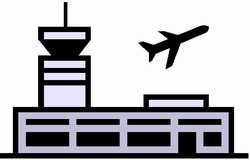Thu, Jun 17, 2010
New Phraseology Goes Into Effect June 30th
 Beginning at the end of this month,
Air Traffic Controllers will no longer be using the phase "Taxi To"
when clearing aircraft to an assigned takeoff runway.
Beginning at the end of this month,
Air Traffic Controllers will no longer be using the phase "Taxi To"
when clearing aircraft to an assigned takeoff runway.
The change establishes the requirement that an explicit runway
crossing clearance be issued for each runway (active, inactive, or
closed) crossing and requires an aircraft or vehicle to have
crossed the previous runway before another runway crossing
clearance may be issued. At airports where the taxi route between
runway centerlines is less than 1,000 feet apart, multiple runway
crossings may be issued after receiving approval by the Terminal
Services Director of Operations. Aircraft will no longer
automatically be authorized to cross all runways and taxiways which
the taxi route intersects except the assigned runway.
In the amended taxi and ground order procedures, controllers are
instructed to issue the route for the aircraft or other vehicle to
follow on the movement area in concise and easy to understand
terms. The taxi clearance must include the specific route to
follow. When a taxi clearance to a runway is
issued to an aircraft, controllers should confirm the aircraft has
the correct runway assignment. A pilot's read back of taxi
instructions with the runway assignment can be considered
confirmation of runway assignment.
 Movement of aircraft or vehicles on
nonmovement areas is the responsibility of the pilot, the aircraft
operator, or the airport management. Controllers are told that when
authorizing either to proceed on the movement area, or to any point
other than assigned takeoff runway, specify the taxi instructions.
If it is the intent to hold the aircraft or vehicle short of any
given point along the taxi route, routes should
be issued followed by holding instructions. The
absence of holding instructions authorizes an aircraft/vehicle to
cross all taxiways that intersect the taxi route.
Movement of aircraft or vehicles on
nonmovement areas is the responsibility of the pilot, the aircraft
operator, or the airport management. Controllers are told that when
authorizing either to proceed on the movement area, or to any point
other than assigned takeoff runway, specify the taxi instructions.
If it is the intent to hold the aircraft or vehicle short of any
given point along the taxi route, routes should
be issued followed by holding instructions. The
absence of holding instructions authorizes an aircraft/vehicle to
cross all taxiways that intersect the taxi route.
Under the new procedure, an authorization for an aircraft to
taxi to an assigned takeoff runway should include the departure
runway followed by the specific taxi route. Controllers are
instructed to issue hold short restrictions when an aircraft will
be required to hold short of a runway or other points along the
taxi route.
Finally, the new procedures say that aircraft or vehicles must
receive a runway crossing clearance for each runway that their taxi
route crosses. An aircraft or vehicle must have crossed a previous
runway before another runway crossing clearance may be issued.
The FAA Runway Safety Call to Action Committee issued several
recommendations to address improving runway safety across the NAS.
In response to the Committee's recommendations, the ATO convened a
Safety Risk Management Panel to evaluate the safety of the
Committee recommendations. These are two of the recommended changes
from the Call to Action Committee.
More News
Outboard Section Of The Right Wing And The Right Flap Separated In Flight And The Airplane Impacted A Farm Field Analysis: The pilot was approaching his destination airport under i>[...]
Final Approach Fix The fix from which the final approach (IFR) to an airport is executed and which identifies the beginning of the final approach segment. It is designated on Gover>[...]
"Our choice of when to respond, how to respond and on which targets to respond is a consideration that we make every time... Netanyahu also noted that anyone attacking Israel &ldqu>[...]
Estimated (EST) When used in NOTAMs “EST” is a contraction that is used by the issuing authority only when the condition is expected to return to service prior to the e>[...]
Aero Linx: Coalition of Airline Pilots Associations (CAPA) The Coalition of Airline Pilots Associations (CAPA) is the world’s largest pilot trade association representing ove>[...]
 NTSB Final Report: Cessna 177B
NTSB Final Report: Cessna 177B ANN's Daily Aero-Term (05.08.25): Final Approach Fix
ANN's Daily Aero-Term (05.08.25): Final Approach Fix Aero-News: Quote of the Day (05.08.25)
Aero-News: Quote of the Day (05.08.25) ANN's Daily Aero-Term (05.09.25): Estimated (EST)
ANN's Daily Aero-Term (05.09.25): Estimated (EST) ANN's Daily Aero-Linx (05.09.25)
ANN's Daily Aero-Linx (05.09.25)




